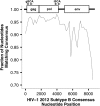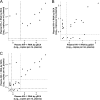Improved single-copy assays for quantification of persistent HIV-1 viremia in patients on suppressive antiretroviral therapy
- PMID: 25187636
- PMCID: PMC4313209
- DOI: 10.1128/JCM.02060-14
Improved single-copy assays for quantification of persistent HIV-1 viremia in patients on suppressive antiretroviral therapy
Abstract
A quantitative real-time PCR (qRT-PCR) assay with single-copy sensitivity targeting HIV-1 gag RNA (the gag single-copy assay [gSCA]) has been used widely to quantify plasma viremia below the limit of detection of clinical assays in patients on effective antiretroviral therapy (ART), but viral RNA in 15 to 30% of samples amplifies inefficiently because of primer/probe mismatches. We sought to develop improved single-copy assays with increased sensitivity by improving nucleic acid recovery, designing qRT-PCR primers and a probe for a highly conserved region of integrase in the HIV-1 pol gene (the integrase single-copy assay [iSCA]), and increasing the plasma volume tested (Mega-iSCA). We evaluated gSCA versus iSCA in paired plasma samples from 10 consecutive patients with viremia of >1,000 copies/ml and 25 consecutive patients on suppressive ART. Three of 10 viremic samples amplified inefficiently with gSCA compared to the Roche Cobas Ampliprep/TaqMan 2.0, whereas all 10 samples amplified efficiently with iSCA. Among 25 samples from patients on suppressive ART, 8 of 12 samples that were negative for HIV-1 RNA by gSCA had detectable HIV-1 RNA by iSCA, and iSCA detected 3-fold or higher HIV-1 RNA levels compared to gSCA in 10 of 25 samples. Large-volume plasma samples (>20 ml) from 7 patients were assayed using Mega-iSCA, and HIV-1 RNA was quantifiable in 6, including 4 of 5 that were negative by standard-volume iSCA. These improved assays with superior sensitivity will be useful for evaluating whether in vivo interventions can reduce plasma viremia and for assessing relationships between residual viremia and other virologic parameters, including the inducible proviral reservoir.
Copyright © 2014, American Society for Microbiology. All Rights Reserved.
Figures



References
-
- Fiebig EW, Wright DJ, Rawal BD, Garret PE, Schumacher RT, Peddada L, Heldebrandt C, Smith R, Conrad A, Kleinman SH, Busch MP. 2003. Dynamics of HIV viremia and antibody seroconversion in plasma donors: implications for diagnosis and staging of primary HIV infection. AIDS 17:1871–1879. 10.1097/00002030-200309050-00005. - DOI - PubMed
-
- Mellors JW, Muñoz A, Giorgi JV, Margolick JB, Tassoni CJ, Gupta P, Kingsley LA, Todd JA, Saah AJ, Detels R, Phair JP, Rinaldo CR., Jr 1997. Plasma viral load and CD4+ lymphocytes as prognostic markers of HIV-1 infection. Ann. Intern. Med. 126:946–954. 10.7326/0003-4819-126-12-199706150-00003. - DOI - PubMed
Publication types
MeSH terms
Substances
Grants and funding
LinkOut - more resources
Full Text Sources
Other Literature Sources
Medical

